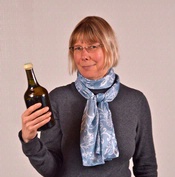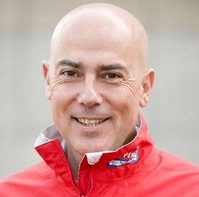|
|
 |
.jpg)
This year was a good year in wine for me. I am grateful that I get to travel to wine regions around the world and meet people who generously share their time, knowledge, experience and wines. One of the aspects I most appreciate about wine as a subject of study--aside from the enjoyment factor--is that one will never learn it all. Following are brief profiles of just a few of the people who taught me more about wine in 2016: Wink Lorch, Pascal Marty, Patrick Valette, Tom Donahue and Sabrina Lueck.
Wink Lorch, Jura wines
I knew of Wink Lorch before meeting her at the TEXSOM Conference in August, because we are both members of the London-based Circle of Wine Writers. I knew she had written a book on Jura wines, and was looking forward to hearing her presentation at the conference. What I didn’t know is how down to earth, approachable and funny she is. She is a great  presenter and knows how make a complex subject easy to understand. She often had the full house crowd of wine geeks laughing out loud. presenter and knows how make a complex subject easy to understand. She often had the full house crowd of wine geeks laughing out loud.
She spent the first part of her presentation debunking the myths about the Jura, a small wine region in eastern France. She describes the region as “tiny and crazily diverse, really hard to understand. It’s upside down and breaks all the rules.” For example, reds are chilled and traditionally served before whites, which are warmer than the reds.
She offered a litany of beliefs about the Jura that are not true: The Jura and Savoie are linked…not. The vineyards are at high altitudes…not. All the grapes are farmed organically…not. All the grape varieties are rare…not. Jura reds are rosés in disguise…not. All whites are oxidized…not. Vin Jaune is the main wine of the region…not. It’s only four percent of the wines produced. Tiny production…true.
After writing about wines from the region for 12 years, Wink self-published her crowd-funded book, Jura Wine. It won the Andre Simon Food and Drinks Award for the best drinks book of 2015. Take that, you stingy, unimaginative publishers. The book is a must for your wine library.
Pascal Marty, Viña Marty, Curicó Valley
In a previous Wine Review Online column, I wrote about the amazing Evaluation of the Harvest public tasting in Brazil. I was honored to be one of 16 international judges who were asked to comment in a blind tasting on the top 16 wine best representing the 2016 harvest. On the evening before the tasting, we met with the organizers from the Brazilian Association of Enology to learn about how the tasting would be conducted and to meet the other judges. At dinner, I happened to sit next to Pascal Marty, introduced as the owner-winemaker at Viña Marty in Chile. Ah, but that was only part of his story.
As dinner progressed I learned that he had worked as enologist at Château Mouton-Rothschild. And then, he moved to Napa Valley to work on the Mouton joint-project with Robert Mondavi. Yes, Opus One. We did have  a bit of fun gossiping about what really went on during the project. And then, he moved to Chile to create Almaviva, Mouton’s joint-project with Concho y Toro. a bit of fun gossiping about what really went on during the project. And then, he moved to Chile to create Almaviva, Mouton’s joint-project with Concho y Toro.
Marty epitomizes my view that people who are truly accomplished don’t have to boast about how accomplished they are. He is modest, quiet and soft-spoken, yet he is clearly in the top tier of winemakers in the world. He is selling his wines in the U.S. and facing the expectations of the trade that wines from Chile should be inexpensive. I encouraged him to be sure to tell U.S. retailers more about his winemaking experience. He does make several wines at different price ranges including a top of the line, single vineyard red blend, Clos de Fa from Pirque. The only one of the line I could find in the U.S. is Viña Marty, Pirca Gran Reserva, from the Maule Valley, which sells for about $12. I haven’t tasted any of the wines from Viña Marty, but based on the winemaker’s credentials alone, I’d buy them.
Patrick Valette, Viña Vik, Millahue Valley
Patrick Valette is another soft spoken, modest, truly accomplished winemaker whom I met this year with Chilean- French connections. I wrote a column for Wine Review Online in August about Valette’s role in Alexander Vik’s ambitious project in the Millahue Valley across the mountains from Apalta. Viña Vik is a massive project with intense attention to the details of producing fine wines. During the few days I visited, Valette unstintingly shared his philosophy, knowledge and ideas about the creation of Viña Vik.
The careers of Valette and Marty are eerily similar. They’ve both worked with Robert Mondavi, made wine in Bordeaux, California, Uruguay and, of course, Chile. They’ve made enough wine in enough different places that they know it’s not possible to force different places to make the same wine. The place determines the wine, but it doesn’t hurt if you have the wisdom, experience and resources to help the place make the best wine possible.
To my taste, they also have a connection in the style and quality of their winemaking. At the end of my visit to Viña Vik we were able to blind-taste ten, top-quality red wines from Chile. In my notes, I recognized a similarity of structure and elegance between Vik 2011 and Almaviva 2011. Granted, Marty did not make the Almaviva, but he did create the model and foundation program that produced it. Clearly Chile is attractive to these two winemakers who have roots in Bordeaux. Certainly the land, its availability and affordability, is a factor. Then there is the freedom to give birth to an entirely new wine like Almaviva, or to plant a virgin wine area like the Millahue Valley to create the wines of Viña Vik.
College Cellars Walla Walla, Washington
I was inspired by a visit to College Cellars Walla Walla, a bonded winery within the Walla Walla Community College Institute of Enology and Viticulture in Walla Walla, Washington. The purpose of the visit was to find the story behind the many awards won by student-made wines for an article for TEXSOM’s annual publication, Sommelier.
Tim Donohue, energetic professor of all-things-wine, told me that he considers awards from commercial wine competitions to be the equivalent of the peer review process required in other academic programs. He enters student wines in many competitions and, as in many commercial wineries, medals, awards plaques and certificates are on display in the school’s tasting room.
The program starts off with a bang. Students are thrown into the maelstrom of harvest their first semester. They pick grapes and make wine knowing nothing more about the process than the experience they might bring with them. Trial by fire…or juice, as in this case. They get to know the exhausting, messy and purple-stained hands side of wine. Illusions of being the star of winemaker dinners are shattered. Some students give it up then. Where’s the glamor?
Sabrina Lueck, who also teaches winemaking and manages student winemakers during harvest explained they are able to make wine in the first semester because ETS, the Napa Valley-based wine analysis laboratory, is on campus. ETS provides analysis, the faculty helps the students manage their wines and the students are able to learn first-hand how and why analysis is important to the health to their wines and their grades. By the time they take their wine science classes, they can relate the classroom exercises to practical application.
Donohue said the students in the program have ranged in age from 18 to 73. Career goals range from first job to midlife change of career. For example, I met two former Air Force pilots who have started a winery and an Amazon attorney who wanted to leave the city and change careers. Not surprisingly, the local winemaking community is very supportive of the school and many graduates are able to find employment in the area. I was so impressed with the program, faculty and students I want to sign up.
I am grateful to these people who enriched my life in 2016: Wink Lorch, a writer and educator who has the talent and enthusiasm to make an obscure and complicated wine region approachable and enjoyable. Patrick Valette and Pascal Marty, two distinguished, yet humble, highly skilled, experienced winemakers who continue to strive for excellence, and willing to share their insights. And a dynamic team of educators including Tom Donahue and Sabrina Lueck, who are educating and inspiring new winemakers to make award-winning wines. It’s been a good wine year.
|
 |
|